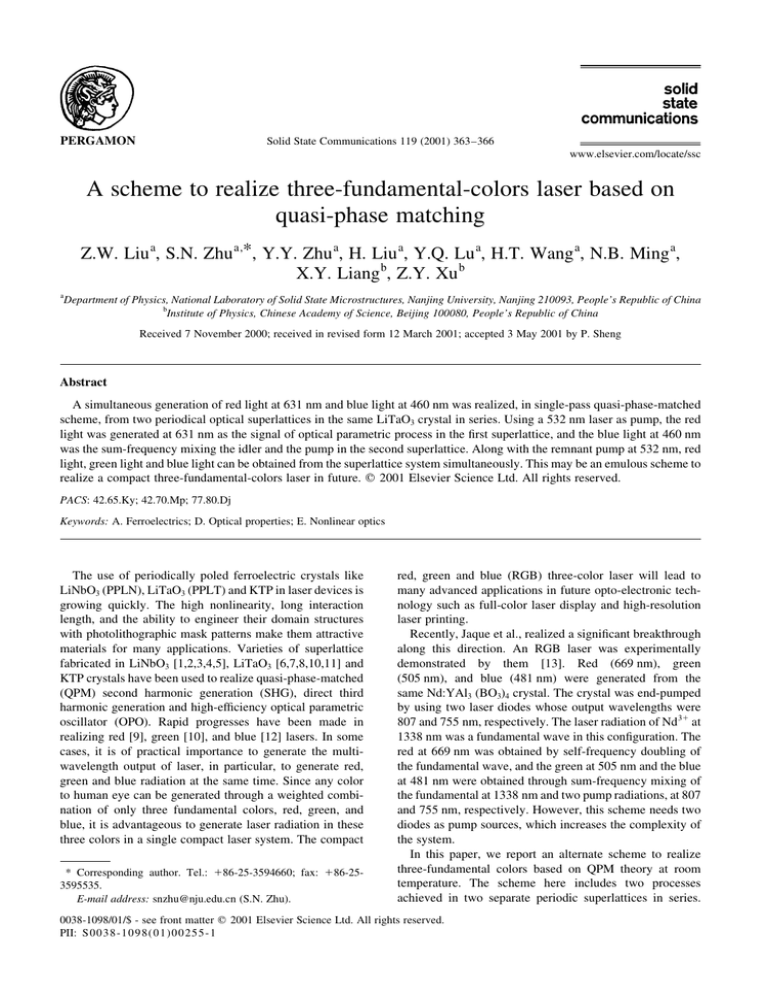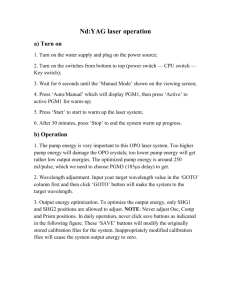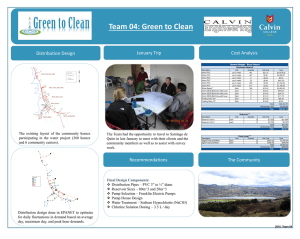
PERGAMON
Solid State Communications 119 (2001) 363±366
www.elsevier.com/locate/ssc
A scheme to realize three-fundamental-colors laser based on
quasi-phase matching
Z.W. Liu a, S.N. Zhu a,*, Y.Y. Zhu a, H. Liu a, Y.Q. Lu a, H.T. Wang a, N.B. Ming a,
X.Y. Liang b, Z.Y. Xu b
a
Department of Physics, National Laboratory of Solid State Microstructures, Nanjing University, Nanjing 210093, People's Republic of China
b
Institute of Physics, Chinese Academy of Science, Beijing 100080, People's Republic of China
Received 7 November 2000; received in revised form 12 March 2001; accepted 3 May 2001 by P. Sheng
Abstract
A simultaneous generation of red light at 631 nm and blue light at 460 nm was realized, in single-pass quasi-phase-matched
scheme, from two periodical optical superlattices in the same LiTaO3 crystal in series. Using a 532 nm laser as pump, the red
light was generated at 631 nm as the signal of optical parametric process in the ®rst superlattice, and the blue light at 460 nm
was the sum-frequency mixing the idler and the pump in the second superlattice. Along with the remnant pump at 532 nm, red
light, green light and blue light can be obtained from the superlattice system simultaneously. This may be an emulous scheme to
realize a compact three-fundamental-colors laser in future. q 2001 Elsevier Science Ltd. All rights reserved.
PACS: 42.65.Ky; 42.70.Mp; 77.80.Dj
Keywords: A. Ferroelectrics; D. Optical properties; E. Nonlinear optics
The use of periodically poled ferroelectric crystals like
LiNbO3 (PPLN), LiTaO3 (PPLT) and KTP in laser devices is
growing quickly. The high nonlinearity, long interaction
length, and the ability to engineer their domain structures
with photolithographic mask patterns make them attractive
materials for many applications. Varieties of superlattice
fabricated in LiNbO3 [1,2,3,4,5], LiTaO3 [6,7,8,10,11] and
KTP crystals have been used to realize quasi-phase-matched
(QPM) second harmonic generation (SHG), direct third
harmonic generation and high-ef®ciency optical parametric
oscillator (OPO). Rapid progresses have been made in
realizing red [9], green [10], and blue [12] lasers. In some
cases, it is of practical importance to generate the multiwavelength output of laser, in particular, to generate red,
green and blue radiation at the same time. Since any color
to human eye can be generated through a weighted combination of only three fundamental colors, red, green, and
blue, it is advantageous to generate laser radiation in these
three colors in a single compact laser system. The compact
* Corresponding author. Tel.: 186-25-3594660; fax: 186-253595535.
E-mail address: snzhu@nju.edu.cn (S.N. Zhu).
red, green and blue (RGB) three-color laser will lead to
many advanced applications in future opto-electronic technology such as full-color laser display and high-resolution
laser printing.
Recently, Jaque et al., realized a signi®cant breakthrough
along this direction. An RGB laser was experimentally
demonstrated by them [13]. Red (669 nm), green
(505 nm), and blue (481 nm) were generated from the
same Nd:YAl3 (BO3)4 crystal. The crystal was end-pumped
by using two laser diodes whose output wavelengths were
807 and 755 nm, respectively. The laser radiation of Nd 31 at
1338 nm was a fundamental wave in this con®guration. The
red at 669 nm was obtained by self-frequency doubling of
the fundamental wave, and the green at 505 nm and the blue
at 481 nm were obtained through sum-frequency mixing of
the fundamental at 1338 nm and two pump radiations, at 807
and 755 nm, respectively. However, this scheme needs two
diodes as pump sources, which increases the complexity of
the system.
In this paper, we report an alternate scheme to realize
three-fundamental colors based on QPM theory at room
temperature. The scheme here includes two processes
achieved in two separate periodic superlattices in series.
0038-1098/01/$ - see front matter q 2001 Elsevier Science Ltd. All rights reserved.
PII: S 0038-109 8(01)00255-1
364
Z.W. Liu et al. / Solid State Communications 119 (2001) 363±366
QPM parametric lights were generated in the ®rst superlattice when it was pumped at 532 nm. The wavelengths
of signal and idler were 631 and 3392 nm, respectively.
The blue at 460 nm was obtained in the second superlattice
through a QPM sum-frequency process of mixing the pump
at 532 nm and the idler at 3392 nm generated in the ®rst
superlattice. Thus, we obtained three-fundamental colors,
the red at 631 nm, the blue at 460 nm and the green at
532 nm, from the output end of the second superlattice by
combination of these two QPM processes.
In order to avoid a complicated con®guration, we
designed and fabricated these two periodic superlattices in
the same LiTaO3 crystal wafer in series. The ®rst is for
optical parametric process and the second is for sumfrequency generation. For a collinear optical parametric
interaction, the ®rst order QPM condition in the ®rst
superlattice is
kp 2 ks 2 ki 2
2p
0
L1
1
where L 1 is the period of the superlattice, kp, ks and ki are
the wave vectors of pump, signal and idler, respectively. In
addition, in a three-wave nonlinear interaction, the
frequencies are related by
vp vs 1 vi
2
where v p, v s and v i are the frequencies of pump, signal and
idler, respectively. According to Eqs. (1) and (2), we trace
the tuning curve of signal and idler that corresponds to the
pump wavelength at 532 nm and the operating temperature
at 258C, versus the period L 1 of the ®rst superlattice, as
shown in Fig. 1. The theoretical curve is calculated from
dispersion [15]. Choosing the period of the ®rst superlattice
at the arrow point in Fig. 1, a red at 631 nm as a signal and
an infrared at 3392 nm as an idler can be obtained. The
corresponding period L 1 is 11.9 mm.
Fig. 1. First-order QPM period for collinear optical parametric
process with 532 nm pump. All the waves are polarized parallel
to the z axis of crystal. We chose the period of superlattice
(11.9 mm) at the arrow points.
The second superlattice should be used to realize a QPM
sum-frequency process in which two added parametric
waves were the idler at 3392 nm and the pump at 532 nm,
respectively. According to energy conservation, the
generated wave is a blue at 460 nm. The QPM condition
corresponding to the sum-frequency process is
ka 2 ki 2 kp 2
2pm
0
L2
3
where ki, kp and ka are the wave vectors of idle, pump and
sum-frequency whose wavelengths are 3392, 532 and
460 nm, respectively, and m the order of QPM. The period
of the second superlattice, L 2, can be established from
Eq. (3). Along with the red at 631 nm generating in the
®rst superlattice and the remnant pump at 532 nm, the
three fundamental colors, red, green and blue, can be
transmitted from the output-end of superlattice system
simultaneously.
Due to some uncertainties in the Sellmeier equation and
the operation temperature, the second superlattice was
designed into a multigrating structure: four parallel gratings,
each 1 mm wide, with periods ranging from 8.74 to 8.80 mm
in the step of 0.02 mm. These periods correspond to a ®rstorder QPM sum-frequency process. The perfect phase
matching of sum frequency was accomplished by translating
the gratings through the pump beam.
The sample was fabricated by poling at room temperature
[14]. Two superlattices were in the same LiTaO3 crystal
wafer and arrayed in series. They were respectively poled
in order to make their duty cycle uniform on account of their
different domain periods. The thickness of sample was
0.5 mm and the lengths of the ®rst and the second superlattices were 2 and 1 cm, respectively. After poling, two end
faces of the crystal wafer were polished for optical measurement, but not coated.
The schematic setup for the measurement of three-fundamental colors is shown in Fig. 2. The 532 nm pump radiation came from the second harmonic output of a ps-Nd:YAG
laser (PY61-10, Continuum, Santa Clara, CA) with a pulse
width of 43 ps and a repetition rate of 10 Hz. The pump
beam was z-polarized and propagated along the x-axis of
the sample as shown in Fig. 2. The beam was weakly
focused and coupled into the polished end face of the
sample. The foci of the focus lens is 400 mm, and the radius
of the beam waist inside the sample was around 0.1 mm. A
prism was used to separate the lights with different wavelengths at the end of sample.
Fig. 2. Experimental setup for measuring three-fundamental-colors
generation in the superlattice sample.
Z.W. Liu et al. / Solid State Communications 119 (2001) 363±366
365
Fig. 4. The average power of red and blue lights versus the average
power of pump.
Fig. 3. Red and blue light spectra measured in the superlattice
sample pumped by a 532 nm laser. The peaks for red and blue
were at (a) 631 nm and (b) 460 nm, respectively.
RGB were detected from the output end of the sample
simultaneously. Fig. 3 shows the red and blue spectra at the
pump wavelength of 532 nm. The spectra were recorded by
a CCD spectrograph (SpectraPro w-750, Acton, MA). The
peak of red light was located at 631.0 nm with the full width
at half maximum (FWHM) of 1.2 nm (Fig. 3(a)). The wide
linewidth veri®ed that the red was a parametric ¯uorescence. The peak of blue shown in Fig. 3(b) was located at
459.8 nm with the FWHM of 0.2 nm. The narrow linewidth
at blue implied that only a small portion of idler participated
in the QPM sum-frequency process due to wide linewidth of
the idler and narrow acceptable bandwidth of the second
superlattice. Though the peak power of the pump light is
very high, the photorefractive effect is little because of the
low repetition rate.
In the limit of low gain and phase matching, the single
pass parametric gain is given by Ref. [16]
G
L {Es
L=Es
0}2 2 1 ,
2vs vp dQ Ip L2
np ni ns 10 c3
4
where Ip is the pump intensity and L is the interaction length
in the ®rst superlattice and np, ni, and ns are the refraction
indices of the pump, idler and signal. 1 0and c are the
dielectric constant and the speed of light in vacuum, respec-
tively. v s, v p are the frequency of the signal and pump,
dQ 2d33 =p is the ®rst-order effective nonlinear
coef®cient for a QPM superlattice material. Harris noted
that the parametric gain and the conversion ef®ciency of
SHG are equal in the low gain limit [17]. The gain available
for parametric interaction in a superlattice crystal like
LiNbO3 or LiTaO3 using the maximum d33 coef®cient
opens the possibility of simultaneously generating RGB
three-fundamental-colors laser with low threshold
operation. Under our experimental condition, the red parametric ¯uorescence was generated when the average pump
power is over 0.08 mW.
Fig. 4 shows the measured power of red and blue versus
the pump power at 532 nm. In our case, we measured the
total power from the end face of the superlattice as the pump
power. We can see that red and blue both increase gradually
with increasing pump powers. The curve of red is in
accordance with Eq. (4) at the lower pump power (average
pump power , 0:8 mW). When the pump power gets higher
(average pump power . 0:8 mW), the curve begins to
deviate from Eq. (4), showing that the small signal approximation can not be satis®ed. The ¯uorescence ef®ciency is
de®ned as h Ps =Pp ; where Ps is the signal power and Pp is
the pump power, respectively. When the pump power is up
to 1.2 mW, the red and blue light can reach 0.38 mW and
55.6 mW, with conversion ef®ciency 31.7 and 4.6%,
respectively.
Even now, the conversion ef®ciencies of single-pass red
and blue generation are still limited by the interaction length
and the diffraction spreading of the focussed laser beam.
However, it is expected that the ef®ciencies can be drastically increased by either con®ning the ®eld to a waveguide
or using antire¯ection coating on the crystal end faces and
laying the crystal inside a cavity. In a cavity, the parametric
oscillation can be built up by repeated re¯ections and
refocusing, which will improve the quality of beam, depress
the linewidth of spectra and raise the gain ef®ciencies
greatly. Therefore, the blue light power can achieve a
considerable level similar to red light power. Moreover,
366
Z.W. Liu et al. / Solid State Communications 119 (2001) 363±366
the ratio of the intensities of red, green and blue can be
adjusted by selecting suitable con®guration and parameters
of the cavity.
In summary, this work reports a scheme to realize threefundamental colors based on QPM theory at room temperature. Two superlattices with different periods were designed
and fabricated in the same LiTaO3 crystal wafer in series.
QPM red light (signal) at 631 nm and IR light (idler) at
3392 nm were generated from the ®rst superlattice pumped
by a 532 nm laser. Blue at 460 nm was generated in the
second superlattice through a QPM sum-frequency process
of mixing the pump 532 nm light and the idler 3392 nm
light, thus, three-fundamental colors were simultaneously
obtained in the scheme. On the other hand, ®xing the
pump laser, red and blue light in different wavelengths
can be obtained by changing the structural parameter of
the two superlattices. The potential high ef®ciency and the
multiplex output wavelength make this scheme emulous to
realize a compact RGB laser.
Acknowledgements
This work is supported by the grant for the State
Key Program for Basic Research of China, by the
National Advanced Materials Committee of China, and
by the National Natural Science Foundation of China
(69938010). S.N. Zhu is also thankful for the support from
a mono-grant RFPP.
References
[1] L.E. Myers, G.D. Miller, R.C. Eckardt, M.M. Fejer, R.L. Byer,
W.R. Bosenberg, Opt. Lett. 20 (1995) 52.
[2] V. Pruneri, J. Webjorn, P.St.J. Russell, D.C. Hanna, Appl.
Phys. Lett. 67 (1995) 2126.
[3] L.E. Myers, R.C. Eckardt, M.M. Fejer, R.L. Byer, W.R.
Bosenberg, Opt. Lett. 21 (1996) 591.
[4] P.E. Powers, T.J. Kulp, S.E. Bisson, Opt. Lett. 23 (1998) 159.
[5] P. Schlup, L.T. McKinnie, S.D. Butterworth, Appl. Opt. 38
(1999) 7398.
[6] P. Baldi, S. Nouh, K. El Hadi, M. de Micheli, D.B. Ostrowsky,
D. Delacourt, M. Papuchon, Opt. Lett. 20 (1995) 1471.
[7] M.E. Klein, D.-H. Lee, J.-P. Meyn, B. Beier, K.-J. Boller,
R. Wallenstein, Opt. Lett. 23 (1998) 831.
[8] U. Strossner, A. Peters, J. Mlynek, S. Schiller, J.-P. Meyn,
R. Wallenstein, Opt.Lett. 24 (1999) 1602.
[9] Y. Inove, S. Konno, T. Kojima, S. Fujikawa, IEEE J. Quant.
Electron. 35 (1999) 1737.
[10] S.N. Zhu, Y.Y. Zhu, N.B. Ming, Science 278 (1997) 843.
[11] S.N. Zhu, Y.Y. Zhu, Y.Q. Qin, H.G. Wang, C.Z. Ge, N.B.
Ming, Phys. Rev. Lett. 78 (1997) 2752.
[12] C.Q. Wang, Y.T. Chow, W.A. Gambling, et al., Appl. Phys.
Lett. 75 (1999) 1821.
[13] D. Jaque, J. Capmany, J.G. Sole, Appl. Phys. Lett. 75 (1999)
325.
[14] S.N. Zhu, Y.Y. Zhu, Z.Y. Zhang, H. Shu, H.F. Wang, J.F.
Hong, C.Z. Ge, N.B. Ming, J. Appl. Phys. 77 (1995) 5481.
[15] J.P. Meyn, M.M. Fejer, Opt. Lett. 22 (1997) 1214.
[16] L.E. Myers, R.C. Eckardt, M.M. Fejer, R.L. Byer, W.R.
Bosenberg, J.W. Pierce, J. Opt. Soc. Am. 12 (1995) 2102.
[17] S.E. Harris, Proc. IEEE 57 (1969) 2096.





